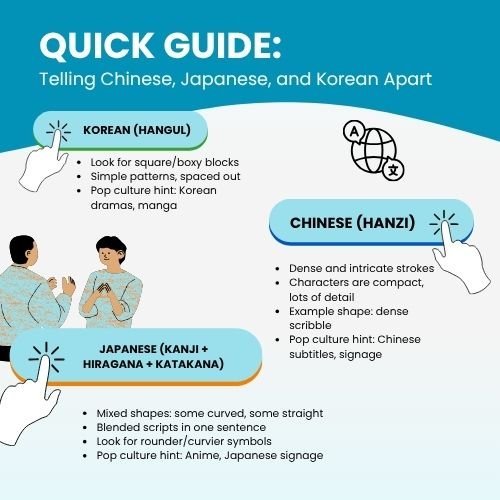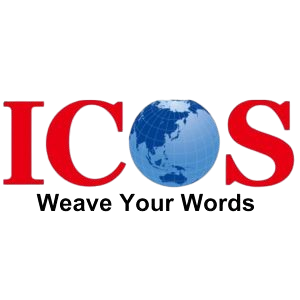Chinese vs Japanese vs Korean Writing: Understanding Their Complexity and Uniqueness
Table of Contents

To have another language is to possess a second soul
Charlemagne
Chinese, Japanese, and Korean are three distinct languages, each with its own writing system, history, and complexities. At first glance, they might seem similar, However, the more you look, the clearer the differences become, and the deeper you dive, the more fascinating they are.
If you can differentiate between Chinese, Japanese, and Korean, it is not only impressive but can way more enhance how you interact with your clients, partners, and customers from these regions.
These three languages, while visually striking, each come with their own set of complexities, and mastering even a few key phrases can take you a long way in establishing trust and rapport.
Over 1.3 billion people speak Chinese, making it the world’s most spoken language.
Japanese, with its three writing systems, weaves together a linguistic tapestry that is as rich as the culture it represents.
Meanwhile, Korean, with its beautifully designed Hangul alphabet, offers one of the most intuitive scripts in the world.
Each language has evolved in its own unique way, and knowing the difference can give your business the edge it needs in these competitive markets.
It can help you in navigating international contracts, building partnerships, or simply aiming to offer personalized customer service.
Understanding these languages—at least on a surface level—can make a world of difference.
Together, let’s break down the nuances that set Chinese, Japanese, and Korean apart, while also exploring their cultural significance and why recognizing these differences matters in business.
We will understand that every stroke, curve, and character carries meaning and that the ability to say something as simple as “thank you” in the right language can open doors to new opportunities.
What Makes Chinese vs Japanese vs Korean Writing Unique?

The writing systems of Chinese, Japanese, and Korean may seem similar at first glance, but they are fundamentally different in structure and complexity. Here’s a breakdown:
Chinese
It is like the foundation—spoken by over a billion people across the globe, with thousands of intricate characters used to represent words and ideas. It’s a language that thrives on its characters, each one holding layers of meaning. Mandarin, the most widely spoken dialect, and Cantonese may share the same script, but their spoken forms differ so much that speakers of each dialect may not understand each other.
For example, take the phrase thank you for visiting. In Traditional Chinese, it’s written 謝謝您的光臨, while in Simplified Chinese, it becomes 谢谢您的光临. Both convey the same sentiment, yet the visual difference lies in how the characters evolved over time to be more accessible.
Fun Fact: There are over 50,000 Chinese characters, but only about 3,500-4,000 are commonly used in daily life
Japanese
It is like a mix of three languages in one—kanji (borrowed from Chinese), hiragana, and katakana. Each writing system has its role, making Japanese incredibly dynamic. While kanji adds depth and complexity, hiragana and katakana create a flow, making the language rich yet approachable.
For Example: the sentence “How often do you read the news?” in Japanese mixes all three: あなたはどのくらいの頻度でニュースを見ますか? The different scripts blend to form a single sentence, making Japanese visually distinct from both Chinese and Korean.
Fun Fact: There are approximately 2,000 commonly used Kanji characters
Korean
On the other hand, stands out with its unique alphabet, Hangul, which is relatively easy to learn. Each symbol represents a sound, and they combine into syllable blocks, creating a neat, boxy appearance. Korean looks simpler and more structured compared to the dense complexity of Chinese characters or the blended nature of Japanese.
For example: in Korean, “Thank you” is written 감사합니다, using characters that look straightforward and clean.
In essence, Chinese relies on complex characters, Japanese mixes characters and syllabaries, and Korean uses a straightforward alphabet.
Why Is It So Difficult? Chinese vs Japanese vs Korean (Which is Harder?)

When it comes to comparing the difficulty of Chinese, Japanese, and Korean, each language poses unique challenges.
Chinese
Chinese stands out due to its use of logograms, specifically characters that represent ideas rather than sounds. It can be difficult for learners because of its vast number of characters (over 50,000, though about 3,000 are commonly used) and tonal nature.
Mandarin, the most spoken dialect, has four tones, each of which changes the meaning of a word. For example, the word “ma” can mean “mother” (妈), “horse” (马), or “scold” (骂) depending on the tone.
Additionally, learners must grasp the difference between Traditional and Simplified Chinese. Simplified Chinese is easier for beginners as it uses fewer strokes. Still, both systems share similar underlying complexities.
Take the sentence, “The weather is nice today”:
- Traditional: 今天天氣很好。
- Simplified: 今天天气很好。
- Pinyin: Jīntiān tiānqì hěn hǎo.
Only one character differs, but both require recognizing intricate strokes.
Japanese
Japanese poses its own set of difficulties due to its three distinct writing systems: Kanji (borrowed from Chinese), Hiragana, and Katakana. Kanji adds depth but demands the memorization of thousands of characters, similar to Chinese. However, the use of Hiragana and Katakana, which are syllabaries, adds a layer of complexity by creating sentences that mix different scripts.
For example, in the sentence “How often do you read the news?” (あなたはどのくらいの頻度でニュースを見ますか), all three scripts are used:
- あなたはどの (Hiragana)
- くらいの頻度見 (Kanji)
- ニュース (Katakana)
The need to switch between these three systems increases the difficulty level, especially when combined with multiple readings for Kanji depending on context.
Korean
Korean is arguably the easiest to learn for beginners because it uses Hangul, a phonetic alphabet that was designed to be easy to learn.
With only 14 consonants and 10 vowels, learners can quickly master its use. However, understanding advanced grammar and honorifics can be tricky. Additionally, traditional Korean used Chinese characters (Hanja), so reading historical texts may require knowledge of both systems.
Hangul syllables are formed by combining letters into syllable blocks, like 감사합니다 (Thank you), making it visually distinctive yet easier to grasp compared to Chinese and Japanese.
Comparison Table
Aspect | Chinese (Mandarin) | Japanese | Korean |
Writing System | Logograms (Simplified/Traditional) | Kanji, Hiragana, Katakana | Hangul (Alphabet) |
Characters | 50,000+ (3,000 common) | 2,000 Kanji, 46 Hiragana, 46 Katakana | 14 consonants, 10 vowels |
Grammar | Simple, SVO structure | Complex, SOV structure | Moderate, SOV structure |
Pronunciation | 4 tones (Mandarin) | Few tones, but varied readings for Kanji | No tones |
Difficulty | High (tones, characters) | High (Kanji complexity, grammar) | Moderate (alphabet, grammar) |
In conclusion, determining which language is the hardest really depends on your own interests and approach.
The hardest language is the one you’re least motivated to learn.
Chinese has an intimidating start with tones and characters but it becomes easier once you get past that.
Japanese starts out simpler but its complexities emerge later, particularly in nuanced communication.
Korean strikes a balance, with an easy alphabet but more intricate grammar.
Ultimately, the journey you enjoy the most will feel less difficult, no matter the language.
How to Distinguish Japanese from Korean and Chinese Writing?

For a beginner, telling these scripts apart may seem like spotting the differences in a puzzle. But with some tips, it becomes easier. To distinguish Japanese, Korean, and Chinese writing, start by observing the structure of the characters:
Korean
(Hangul) consists of simple blocks formed by combining letters, often repeating patterns. It has more spaces and looks less dense compared to Chinese or Japanese.
For example:
안녕하세요 (Annyeonghaseyo) – meaning “Hello.”
Chinese
Characters (Hanzi) are intricate and compact, often containing more strokes. Chinese doesn’t use separate alphabets like Japanese does.
For example :
你好 (Nǐ hǎo) – meaning “Hello.”.
Japanese
Kanji, Hiragana, Katakana combines Chinese Kanji with curvier Hiragana or Katakana. Look for rounder or curvier symbols like these: あ, い, う, which are unique to Japanese.
For example:
こんにちは (Konnichiwa) – written in Hiragana for “Hello” and can also include Kanji like 今日は (Kyō wa).
An easy trick is to check for “boxes” around the characters: Korean doesn’t use them, while Chinese and Japanese do. Additionally, spotting mixed writing styles is an indicator of Japanese, as it blends Kanji with syllabaries.
In pop culture, anime subtitles are often in Japanese, while Korean dramas and manga use Hangul. Recognizing these patterns can help you distinguish between the languages.
Why Do Chinese, Korean, and Japanese Look Similar?
There’s a reason these writing systems seem to resemble one another.
Historically, Chinese characters (Hanzi) have deeply influenced both Japanese and Korean scripts. During ancient times, both Japan and Korea adopted Chinese characters for writing.
While Korea later developed Hangul to simplify things, Japanese writing retains Chinese Kanji for many of its words.
This shared history creates a visual similarity, even though the languages themselves differ vastly in pronunciation, grammar, and structure.
Frequently Asked Questions
Both are challenging, but Chinese is harder due to its character complexity, while Japanese is difficult because of its three writing systems.er mattis, pulvinar dapibus leo.
They share some historical roots, but Korean uses Hangul, an alphabet, while Chinese uses complex logograms.
Hangul is a simple phonetic alphabet, whereas Chinese uses logograms, and Japanese mixes syllabaries with Kanji.
Over 1.5 billion people speak Mandarin, Cantonese, Korean, or Japanese globally.
Japanese blends Chinese Kanji characters with its native Hiragana and Katakana syllabaries.
Signing Off:
As we conclude our exploration of the intricacies of Mandarin, Japanese, and Korean, it’s essential to recognize that the journey of learning these languages goes beyond mere vocabulary and grammar.
Each language opens a door to a rich tapestry of culture, history, and perspective. The challenges inherent in mastering these languages—whether it’s navigating tones in Mandarin, the complexities of Japanese writing systems, or the unique features of Korean script—are all part of a transformative experience that shapes not just our linguistic skills but also our understanding of the world.
Chinese, Japanese, and Korean may appear similar, but their writing systems are distinctly unique and challenging.
For businesses expanding into these markets, accurate translations are crucial to success.
Don’t let the complexity of these languages hold you back.
In case you want to consider outsourcing your translation needs to professionals who can ensure culturally and linguistically accurate content
Please connect with us.
Call us!
